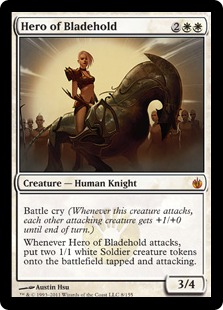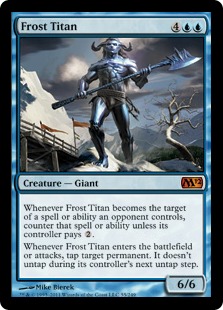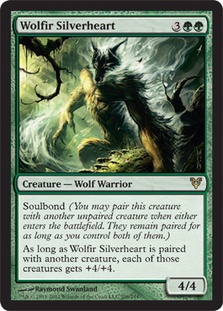It’s been nearly a month since the introduction of M13, so Standard has passed through the initial excitement and desperate search of new ideas and come to a new equilibrium. The Top 8 of SCG Standard Open in Washington, DC contained four Insectile Aberration decks, and five more were in Top 20. The rest of the Top 32 shows format’s diversity: Mono-Green Aggro, Naya Pod, G/R Aggro, Wolf Run Ramp, Zombies, Tezzeret, Infect, U/W/R Control, and Frites. Will the domination of Delver be endless (and for one more year)? The short answer is yes, but the long one is, "Despite Delver’s strike back, a new hope definitely exists."
Insectile Aberration
The time of new ideas has come and gone, so let’s return to the ultimate goal: to be successful in the Delver-determined metagame. First, let’s take a look at the enemy. Talrand, Sky Summoner didn’t oust Restoration Angel from the deck; it’s ended up as a sideboarded weapon against the mirror match (where he is actually awesome) and an occasional maindeck singleton. The typical Delver deck which you will encounter at Kansas City will probably look like the following:
Creatures (15)
Lands (19)
Spells (26)

Ben Friedman and Matthew Costa definitely know what they’re doing; so, despite neither of them didn’t make the top-8 in Washington, D.C., their strong performance (14th and 27th) proved that they have the best version of the "straight" Delver, and his build is the one to be used in your testing gauntlet.
Other versions of the bane presented in DC included different ways to gain an edge in the mirror or against green decks: Augur of Bolas and Blade Splicer from Ben Lundquist, a heavier deck with sideboarding into U/W Midrange from Ben Green, etc., etc. The most successful idea of the tournament was Josh Cho and Charles Gindy Hero of Bladehold Delver, developed by Gerry Thompson.
Creatures (15)
Lands (21)
Spells (24)

Hero of Bladehold isn’t really impressive against Delver decks, but it’s just amazing against any green-based deck, including those that have Bonfire of the Damned. Luis Scott-Vargas had sideboarded Heroes in his WMCQ-winning deck, and members of his team tried different variations some months ago (including, for example, Intangible Virtue), but Team SCG Blue decided to use Hero maindeck at DC. After all, Delver is only one-third of the metagame, and a maindeck Mental Misstep makes Hero better against Vapor Snag.
Note the interesting tech against Zombies: Knight of Glory instead of the conventional Celestial Purge. I’m not sure if this decision is optimal, but the little Knight in combination with Hero of Bladehold allows you to play very aggressively (while Gut Shot takes care of Blood Artist). The Zombies matchup is generally bad for Delver, so any attempt to change deck’s behavior deserves to be investigated in detail.
The Hero of Bladehold deck is not the only one unconventional version of Delver which has had some success. Drogskol Captain, while being ignored by SCG Open Series ringers, has had a constant presence on Magic Online. This version was abandoned after the release of Avacyn Restored due to its weakness to Bonfire of the Damned and to the impetuous progress of Restoration Angel Delver decks. Angel is here again (or still here?) threatening Captain’s main advantage (a good mirror match), but Spirit tokens are far better than Talrand’s Invocations and are able to outrace problematic creatures like Thragtusk. Is it time for Drogskol Captain again?
Creatures (16)
Lands (22)
Spells (22)

I’m not sure if Vault of the Archangel is actually superior to Moorland Haunt, but in my Magical Christmasland lifelink lets you win damage races, which is the main thing this deck wants to do. The rest of the deck is more or less obvious, with inclusion of Gut Shot as an answer to the Delver-Birds of Paradise duality of the format and Revoke Existence instead of Divine Offering due to Rancor.
Frost Titan
What are other ways to beat Delver? They didn’t change much; the only new deck (composed from old cards) is Wolf Run Blue, recently advocated by Reid Duke and Gerard Fabiano.
Creatures (14)
Lands (26)
Spells (20)
Sideboard

Reid and Gerard recently cut some Frost Titans from the deck in the favor of more versatile cards like Thragtusk and Phantasmal Image, but I think that more comboish mana-denial deck is possible too. Adding Tamiyo, the Moon Sage to the mix (exactly as Gerard Fabiano did), we can oust the opponent from the game. Acidic Slime would be better with Phantasmal Image, but Tamiyo is a power by herself (and is just amazing with Temporal Mastery), so I’d better play her. Here’s my attempt on dedicated mana denial deck:
Creatures (10)
Planeswalkers (2)
Lands (26)
Spells (22)

The idea is to ramp as fast as possible (though I cut two Sphere of the Suns from the original mix I tested due to topdeck quality problems) and then to start playing Titans until your opponent concedes. I’m still a fan of Cackling Counterpart over Phantasmal Image because our creatures are generally superior to opposing ones; our deck doesn’t really feel the difference between two and three mana, and flashing Cackling Counterpart back is the real deal. The only problem is double blue mana cost, but it’s rarely critical.
Wolf Run Blue is a perfect weapon if you want to put your opponents into an unwinnable position regardless of what they are playing, but, like any comboish deck, it’s a sort of glass hammer. I like similar decks and feel better playing them, but if you’re going to play Wolf Run Blue, try both combo version and Reid Duke winning attempt. It’s not as devastating, but it’s more stable, which might fit your own play style better.
Other ramp decks seem to be viable contenders again. The metagame has shifted away from Sword of War and Peace, partly because Delver decks now play Talrand, Sky Summoner (who is, in contrast to Restoration Angel and Hero of Bladehold, weak to Whipflare). Also, Mono-Green and G/R Aggro have almost stopped playing Wolfir Silverheart. The big Wolf was the main reason why the matchup between ramp and aggro drastically changed and the reason why many people (including me) avoided Wolf Run Ramp; a poor matchup against the most popular deck in exchange for good matches against other decks was acceptable, but a bad matchup against the most popular deck and a coin-flip against the second one was not a real choice.
Now Wolf Run Ramp, while not being as good as a week ago when all the Delver pilots tried Talrand, Sky Summoner, is a good choice. Moreover, after its failure in Washington DC, I expect the second wave of Combo Elves sometime in the next two weeks, and Whipflare is the best possible weapon against them.
Rancor
Green-based decks are the most important Delver contenders, but they are categorized into many archetypes so pilots’ effort in the development of decks isn’t as effective as it could be. Look at ridiculous SCG Standard Open: Washington, DC Top 4: Joshua Cho, Ben Lundquist, Charles Gindy, and Reid Duke. Three of the four players piloted Delver. Right under the Top 8 were Ben Friedman, Matt Costa, and Shaheen Soorani—all with Delver. For great player, it’s easier to gain an advantage in the top deck’s mirror match due to skill than to break the metagame with something new and different (this is why Brian Kibler and Patrick Chapin are in the Hall of Fame).
Naya Pod, Naya Aggro, Mono-Green Aggro…the question is what you prefer: a stable mana base or better card quality. But the three-colored decks are unable to use one of the best cheap creatures effectively. Strangleroot Geist is a staple of green decks, but variations of Naya must substitute him with Thalia, Guardian of Thraben, Mikaeus, the Lunarch, and Elvish Visionary, of whom only Thalia is nearly as good as Geist. Having a great four- and five-mana creature is good, but having castable creatures is what aggressive decks really want to do during first three turns.
Naya Pod (and partially RUG Pod and Bant Pod) has had some success recently and has become the default choice for those who want to play green aggro, but I think that Mono-Green and especially G/R Aggro are criminally underestimated and underplayed. The Top 16 of the SCG Standard Open in DC had a pair of G/R Aggro and a pair of Mono-Green Aggro. I don’t really like the G/R lists from the Open Top 16, so let’s look at the attempt of well-known Magic Online ringer Mini_Gnarls:
Creatures (22)
- 4 Llanowar Elves
- 4 Birds of Paradise
- 3 Borderland Ranger
- 4 Strangleroot Geist
- 4 Huntmaster of the Fells
- 1 Thragtusk
- 2 Thundermaw Hellkite
Lands (23)
Spells (15)

This deck is probably the simplest possible version. Note that Mini_Gnarls has four Rancor and two Sword of Feast and Famine. This mix is near perfect. I’d play one more Green Sun’s Zenith target over Sword of Feast and Famine, probably Wolfir Silverheart to complement two Thundermaw Hellkites and a Thragtusk.
The Thrun, the Last Troll in the sideboard is not very well positioned right now because all Delver decks have 2-3 Phantasmal Image. I’d probably play third Zealous Conscripts in this slot to have some additional advantage over Wolf Run Ramp (which seems to be big contender again) and over the occasional Reanimator. I also used to like having 1-2 Surgical Extraction in the sideboard to use against Zombies, Reanimator, and, more importantly, Delver (in response to Snapcaster Mage’s trigger), but with the addition of Thundermaw Hellkite and exclusion of Swords, Surgical Extraction unfortunately doesn’t fit into sideboarding plan.
That’s all about Standard for today, and the last thing I have is a question for my readers. I’ve recently started preparations for Grand Prix Moscow (which is M13 Sealed), and some of you are probably going to attend GP Boston or GP San Jose (Costa Rica). I used to write about Constructed, but I have some interesting pools to share and some thoughts about the format, about teamwork during Limited testing, etc. Are you interested in reading about M13 Sealed instead of my usual Constructed information or in addition to it? Let me know in comments!



